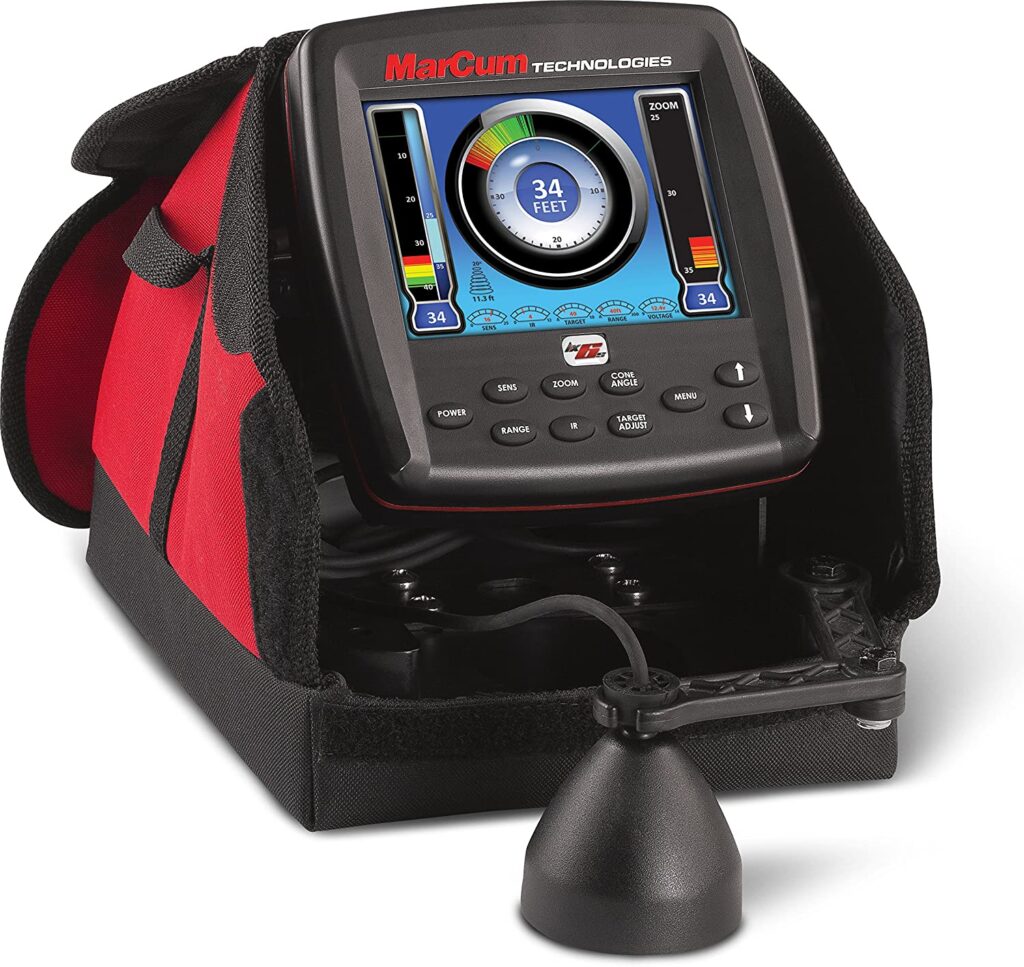
Welcome to our quick review of one of MarCum’s smaller ice finders, the LX-6s. For a quick summary, take a look at the pros and cons along with the specs; we’ll dive into a fuller review of the features after.
| Frequency | 50/200 kHz |
|---|---|
| Transducer | LX-Series Dual Beam 8/20 Degree Ice Transducer |
| Screen | LCD |
| Screen Size | 6" |
| Resolution | 640x480 pixels |
| Backlit | Yes |
MarCum put a lot of effort into making sure the LX6s is easy to read and navigate. This starts with the 6-colour display; red targets are the strongest/biggest/closest, followed by orange, yellow, light green, green and blue. You can also adjust to a variety of other colour palettes, including greyscale.
You can change how information is displayed to suit your fishing style. The unit has a traditional “flasher” style displayer, along with vertical column displays, and a graph mode. What’s more, you can use the split screen function to show a number of these displays simultaneously.
There are several gauges on the unit that allow you to glean information at a glance. These gauges give you information about whether you’re using the 8° or 20° cone, your remaining battery life, your range, and more. You can toggle these gauges on and off.
Having all of that information available on one display is great news; they manage to incorporate it all despite the small size of the display. You can adjust things like the size of the signals being displayed for greater visibility.
The cost of all that information on a small display is that there’s almost no way to make this finder into a touch screen. That means everything needs to be done via touchpad. The touchpad is responsive, but it can take a bit of time to get used to navigating the menus. Those of you who are used to navigating fish finders or who have used other members of MarCum’s LX series should have no problem, though.
There are three important features that we’ve got to talk about (though, obviously, this thing has more than 3 total features). Auto Range is crazy simple: select Auto Range in the Range menu, put your transducer in the water, and the unit will automatically determine the depth you’re fishing in. It doesn’t get more simple than that.
Dynamic Depth is a feature that goes hand-in-hand with your Auto Range. Let’s say the Auto Range determines you’re in 22 feet of water; it will automatically put you in a 40 foot range. You can adjust that with Dynamic Depth, putting the depth at 23 or 24 feet so you can get as much use out of the space on the display as possible.
The Zoom feature is pretty standard, but it’s particularly useful on a screen that can display columns and a flasher simultaneously. With it, you can zoom in on a particular section of the water column, which can be quite useful if you’re trying to single out a particular target when there’s a lot of noise.
Not a lot to say here. The transducer is made for ice fishing, and gives you a narrow and wide cone - narrow for deeper water and precision, wide for when you’re searching for a good place to fish or you’re in shallow water. The transducer works well, and there’s a wide range of interference rejection settings available to reduce noise from other transducers.
This was a quick one, but we’re really impressed with the LX-6s. It’s very portable, the case is much better than the abominable LX-7 case, and it’s very affordable considering how feature-dense it is. The ease of use makes this a great pick for new ice anglers - just Auto Range and start fishing. All in all, the only trouble with this unit is the relatively small screen size (necessary to keep the unit portable and affordable), and even that can be mitigated by using Target Adjust, Zoom, and adjusting sensitivity. A great buy!